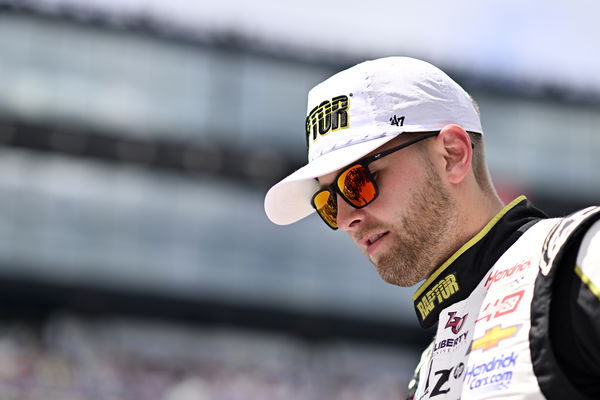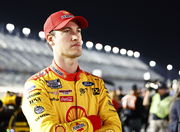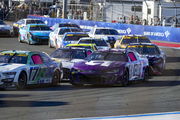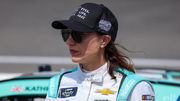
via Getty
BROOKLYN, MICHIGAN – AUGUST 18: William Byron, driver of the #24 RaptorTough.com Chevrolet, walks onstage during driver intros prior to the NASCAR Cup Series FireKeepers Casino 400 at Michigan International Speedway on August 18, 2024 in Brooklyn, Michigan. (Photo by Logan Riely/Getty Images)

via Getty
BROOKLYN, MICHIGAN – AUGUST 18: William Byron, driver of the #24 RaptorTough.com Chevrolet, walks onstage during driver intros prior to the NASCAR Cup Series FireKeepers Casino 400 at Michigan International Speedway on August 18, 2024 in Brooklyn, Michigan. (Photo by Logan Riely/Getty Images)
Let’s rewind to the year 2016 and head to the Charlotte Motor Speedway. What we witnessed was something unprecedented! On May 29, Martin Truex Jr. delivered one of the most dominant drives NASCAR had ever seen. At the Coca-Cola 600, he led 392 of 400 laps – an astonishing 588 miles out front, setting a record for the most miles led in a single race! It was the race that lives on in highlight reels and hushed garage whispers. But, for some NASCAR drivers, dominance doesn’t always guarantee victory.
Fast forward to Darlington 2025, and William Byron looked set to write his own chapter in that book. With a rocket of a race car and nearly flawless execution, he was on pace to pull off a rare NASCAR feat. That is, until a late-race twist turned what could have been a historic night into a heartbreaking near-miss.
ADVERTISEMENT
Article continues below this ad
William Byron reflects on the bittersweet Darlington result
“Was really proud of that,” William Byron said after leading the first 243 laps of Sunday’s Goodyear 400. “They bring that level of effort and preparation.” His Hendrick Motorsports crew delivered a rocket, and Byron looked set to dominate. It wasn’t just speed, it was surgical execution from the drop of the green.
The No. 24 Chevrolet set a blistering pace through green-flag stops and tire cycles. “It was looking like it was going to be a perfect race,” Byron said. But when late-race pit strategies kicked in, Byron messed it up. Rivals like Tyler Reddick and Ryan Blaney emerged in front with just 50 laps to go, as the pit cycle concluded. “Once we lost control, too late in the going to kind of get up back there,” Byron admitted. A caution with four laps to go, triggered by Kyle Larson’s second spin of the day while down 167 laps, set up a late restart. Denny Hamlin took full advantage and surged to the win. Byron, caught out of position, managed to fight back from 4th position but had to settle for second. “It stings in the moment for sure,” he admitted.
However, along the way, William Byron broke several records. Byron’s 243 laps led shattered Bill Elliott’s 1988 Darlington record of 107 laps led from the green flag. Byron swept the first two stages, making him the second driver since the inception of stage racing in 2017 to lead each lap of the first two stages. It was also the most laps led from the start of a NASCAR Cup race since Jeff Burton went wire-to-wire at New Hampshire in 2000, leading all 300 laps. Byron’s run wasn’t just impressive, it was historically dominant.
243 laps led. William Byron a strong day one spot short of a victory in Darlington. #NASCARonFS1 pic.twitter.com/C0RCYSpyBN
— FOX: NASCAR (@NASCARONFOX) April 6, 2025
What’s your perspective on:
Did William Byron's pit strategy cost him a legendary win, or was it just bad luck?
Have an interesting take?
“There’s still a lot of positives,” Byron concluded, refusing to let the finish erase the performance. While the sting remains, his dominance proved he’s a real threat for the rest of the season, including the championship. Records are nice, but Byron’s still chasing wins. Despite winning multiple races already in the 2025 season, his hunger isn’t satisfied yet!
Trending
ADVERTISEMENT
Article continues below this ad
Jeff Burton’s throwback post highlights a rare feat
“When we led every lap @NHMS it took great pit stops, great restarts, great speed, and no green flag stops,” Jeff Burton posted on X, reflecting on William Byron’s Darlington dominance. It was more than just a nod of respect. Burton’s post drew a straight line between two rare feats – his 2000 flag-to-flag dominance at New Hampshire and Byron’s jaw-dropping 243-lap lead at Darlington. The difference? Burton sealed the deal. Byron, heartbreakingly, did not.
However, Burton’s historic race came under unusual circumstances. After the deaths of Adam Petty and Kenny Irwin Jr., NASCAR mandated restrictor plates at Loudon. This made the 2000 Dura Lube 300 more about strategy and execution than sheer speed. With fewer passing chances, clean restarts and pit perfection became everything.
Burton and the No. 99 Roush Racing team nailed it. He led all 300 laps, becoming only the third driver in modern-era NASCAR to lead every lap of a race. No green flag stops meant no margin for error. One bad restart or pit stop could’ve erased history. Previously, only Cale Yarborough had led every lap of a NASCAR race. He did it at Bristol Motor Speedway in 1973 and then again at Nashville Speedway in 1978.
ADVERTISEMENT
Article continues below this ad
Byron’s effort echoed that same precision. But the green flag pit cycle broke the rhythm. Burton’s tweet wasn’t just nostalgia. It was a subtle salute to the level of execution needed to flirt with perfection and a reminder of just how cruelly the sport can deny it. We hope William Byron finds another chance to chase history soon!
ADVERTISEMENT
ADVERTISEMENT
ADVERTISEMENT
ADVERTISEMENT







Did William Byron's pit strategy cost him a legendary win, or was it just bad luck?